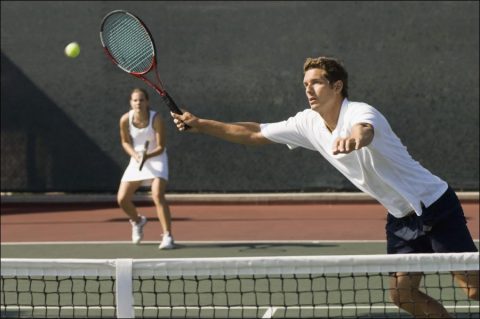I am a great believer in two partners talking to each other, encouraging each other, and working always with a show of friendship. I think it has a definite effect, not only on your partner, to keep him happy and working, but also in making the other team aware of your cooperation toward victory. Do not always try to get the best player as your partner, if you and he are not compatible.
You will not be a good team. Usually two great singles players together do not make a great doubles team. Each is too apt to be an individualist, who wants to run the team, with the result that they never achieve smooth teamwork. They remain two fine singles players, playing singles side by side on a doubles court, but they are not a doubles team.
Examples of that were Donald Budge and Bobby Riggs, or Henri Cochet and Jean Borotra. Budge and Mako were a far finer team than Budge and Riggs, yet Mako was never the great player that Riggs was. Cochet with Brugnon, and Borotra with Brugnon, were both better teams than Cochet and Borotra, yet Brugnon was hardly in the same class as the other two. I have always believed that the really great teams were made up of a clever, steady player who made the openings, and a hard-hitting killer, who won the points through those openings.
It is always the killer who gets the reputation, but it is the man who makes those openings who is the wheel horse of the team and its real strength. It was Mako who gave Budge his chances. Peck Griffin opened for Billy Johnston, John Van Ryn gave Wilmer Allison his openings, George Lott worked out the setups that Lester Stoefen put away.
Among modern players this art is almost lost. Only Frank Parker has the quality that made Mako, Griflin, Van Ryn, Lott and Brugnon among the greatest doubles players in history. Those men are great doubles partners with any hitter.
Get one thing firmly fixed in your mind about playing doubles. You can’t blast your way from the baseline through a doubles team in position at the net. There are two men to cover only thirty-six feet of width on the court.
There just isn’t room enough, until you have moved one or both of them enough to open their court. What are the various ways to open up the holes? They are few but definite. You must go outside, between, or over your opponents, but you can’t hit through them from back court.
To open the court by going on the outside of the team two shots are logical:
1. The straight passing shot down the alley past the player in front of you, which, if played, must be a fast flat drive.
2. A slow cross-court, sharply angled shot, which can be either a slow drive, flat or topspin, or a slow slice.
Both shots must be low and short. The straight shot, either off service or in play, verges on an attempt to win, and is always very aggressively hit. It should not be played as often as the cross-court, since to succeed it needs an element of surprise. The cross-court shot is definitely an attempt to make the opponents volley up so you can win on the next shot, and do es not carry the same chance to win outright as the straight shot.
The most used, and certainly the most popular, shot is the one down the centre between the two opponents.
There are several reasons for this:
1. It is easier to hit and carries less risk of error.
2. It may cause uncertainty between the other two men as to which should play it, so that perhaps both men will let it go, or both will try for it and clash, either of which tends to break up their teamwork and confidence.
3. It provides less angle for the opponents to hit for, and is apt to give you a chance for a winner on the next shot to a sideline, since both men have been pulled in to the centre.
If you decide to open up the court by going over the opposing team, the only shot is the Iob. It is difficult to drive a team away from the net by lobbing but it can be done. Lob high and deep and often, but the moment you sense a tendency in your opponents to hang back and wait for the Iob, shift at once to the drive and go in yourself. If at any time you succeed in getting a Iob over your opponents’ heads, so they are compelled to drop it and hit it off the bound, go in to the net at once, one player clasing the straight shot and the other clasing the centre of the court. Give them the cross-court angle to hit at. They will make one and miss ten, trying it.
Once you have made an opening in your opponents’ court. In doubles, go out for your shot at once. There is not time, or room in the court, to continue manoeuvring them around. Remember always that average pace, except on your service return, is not good. It calls for increased speed, or a really slow delicate pace, to win. Every shot that you play should have the definite object of either winning outright or assisting you in gaining the net position where you can win outright. Doubles is a game of much less depth to the ground strokes than singles. The sharp-angled shot, the fast-dropping drive, the short, slow slice, are used far more than the full long sweeping drive or deep-floating chop. The tempo of doubles is much faster than singles, and many more risks should be taken.
Next Page: General tactical rules for mixed doubles
